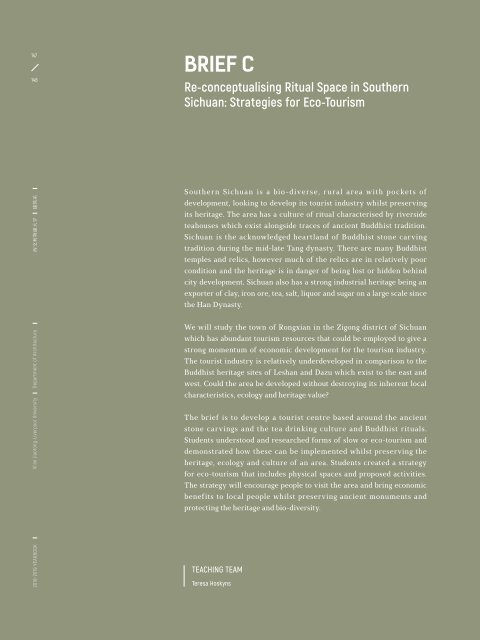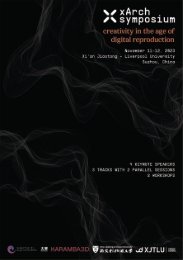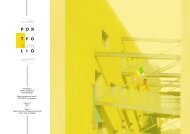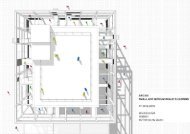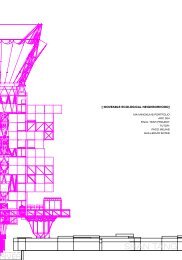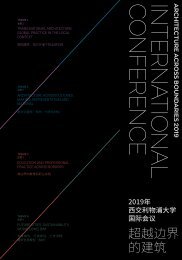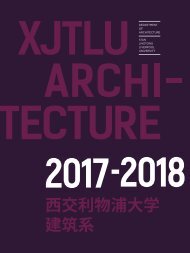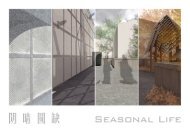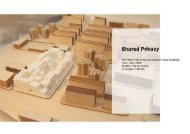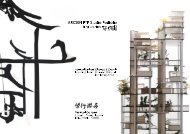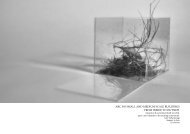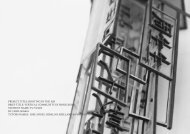YEARBOOK 2018 - 2019 | XJTLU DEPARTMENT OF ARCHITECTURE
The sixth edition of the yearbook of the Department of Architecture at Xi'an Jiaotong-Liverpool University presents student works created during the academic year 2018 - 2019. The yearbook exemplifies the new model for Chinese architectural education for which the department was commended by the Royal Institute of British Architects (RIBA). It is also a showcase of the creative culture that has guided our students towards successful international careers as responsible and creative architectural designers. The Department of Architecture at XJTLU offers RIBA Part 1, 2 and 3.
The sixth edition of the yearbook of the Department of Architecture at Xi'an Jiaotong-Liverpool University presents student works created during the academic year 2018 - 2019. The yearbook exemplifies the new model for Chinese architectural education for which the department was commended by the Royal Institute of British Architects (RIBA). It is also a showcase of the creative culture that has guided our students towards successful international careers as responsible and creative architectural designers. The Department of Architecture at XJTLU offers RIBA Part 1, 2 and 3.
Create successful ePaper yourself
Turn your PDF publications into a flip-book with our unique Google optimized e-Paper software.
147<br />
148<br />
BRIEF C<br />
Re-conceptualising Ritual Space in Southern<br />
Sichuan: Strategies for Eco-Tourism<br />
<strong>2018</strong>-<strong>2019</strong> <strong>YEARBOOK</strong> Xi’an Jiaotong-Liverpool University Department of Architecture 西 交 利 物 浦 大 学 建 筑 系<br />
Southern Sichuan is a bio-diverse, rural area with pockets of<br />
development, looking to develop its tourist industry whilst preserving<br />
its heritage. The area has a culture of ritual characterised by riverside<br />
teahouses which exist alongside traces of ancient Buddhist tradition.<br />
Sichuan is the acknowledged heartland of Buddhist stone carving<br />
tradition during the mid-late Tang dynasty. There are many Buddhist<br />
temples and relics, however much of the relics are in relatively poor<br />
condition and the heritage is in danger of being lost or hidden behind<br />
city development. Sichuan also has a strong industrial heritage being an<br />
exporter of clay, iron ore, tea, salt, liquor and sugar on a large scale since<br />
the Han Dynasty.<br />
We will study the town of Rongxian in the Zigong district of Sichuan<br />
which has abundant tourism resources that could be employed to give a<br />
strong momentum of economic development for the tourism industry.<br />
The tourist industry is relatively underdeveloped in comparison to the<br />
Buddhist heritage sites of Leshan and Dazu which exist to the east and<br />
west. Could the area be developed without destroying its inherent local<br />
characteristics, ecology and heritage value?<br />
The brief is to develop a tourist centre based around the ancient<br />
stone carvings and the tea drinking culture and Buddhist rituals.<br />
Students understood and researched forms of slow or eco-tourism and<br />
demonstrated how these can be implemented whilst preserving the<br />
heritage, ecology and culture of an area. Students created a strategy<br />
for eco-tourism that includes physical spaces and proposed activities.<br />
The strategy will encourage people to visit the area and bring economic<br />
benefits to local people whilst preserving ancient monuments and<br />
protecting the heritage and bio-diversity.<br />
TEACHING TEAM<br />
Teresa Hoskyns<br />
CLIFF TEMPLE STAY:<br />
RITUALISTIC SPACE IN BETWEEN<br />
DIVINITY AND SECULARITY<br />
Dai Yiqing | 戴 怡 青


